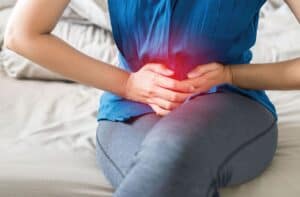
Pelvic pain can be very disruptive to your life, causing pain and discomfort during the day and night when you’re trying to sleep. But if you don’t treat it, you may develop long-term, chronic pelvic pain that never goes away and may even worsen over time.
Fortunately, there are ways to manage pelvic bone pain and even stop it from happening in the first place! Read on to learn more about the definition of pelvic pain , symptoms, causes, diagnosis, treatment, prevention, and more.

Pelvic pain refers to pain in the lower abdomen, pelvis, or perineum—the area between the anus and vulva or scrotum. It can be for a short period or be a chronic long-term problem. Pelvic pain in women can affect them at any age, but it’s most common in women of childbearing age.
Following are some of the most common reasons for pelvic pain:
Other potential causes include:
In some cases, the cause of pelvic pain is unknown.
Pelvic pain can manifest in several ways, including a dull ache, sharp pain, or cramping. The pain may be constant or intermittent and can be exacerbated by activities like sitting for long periods, sexual intercourse, or urination.
In some cases, based on where pelvic pain is located, the pain may radiate to the lower back, thighs, or rectum.
Some other symptoms include the following:
There is no one definitive way to diagnose pelvic pain. Your doctor will likely start by taking your medical history and physical exam. They may also order imaging tests, such as an ultrasound or MRI, to get a better look at your pelvis.
In some cases, they may also recommend a laparoscopy, a minimally invasive surgery that allows them to look inside your pelvis. A laparoscopy can help detect endometriosis, ovarian cysts, fibroids, tumors, and other abnormalities in the uterus.
Most pelvic pain can be treated with a combination of physical therapy, medication, and lifestyle changes. In some cases, surgery may be necessary.
If you’re experiencing pelvic pain, there are a number of medications that can help.
Certain over-the-counter pain relievers such as ibuprofen and acetaminophen may help relieve mild discomfort from menstrual cramps or endometriosis.
For more severe pain, your doctor may prescribe other medicines like acetaminophen with codeine or hydrocodone with acetaminophen.
Sometimes, your doctor may also prescribe an antibiotic to fight infection. The most common type is Metronidazole, which treats bacterial vaginitis and sexually transmitted infections.
Two types of hormone treatments can be used to treat pelvic pain related to endometriosis, uterine fibroids, and hormonal birth control side effects: oral contraceptives and hormones delivered through a patch or injection into the skin.
Oral contraceptives work by altering hormone levels and reducing symptoms associated with menstruation while delivering estrogen directly into the bloodstream through pills taken daily.

Many women find relief from chronic pelvic pain through antidepressants. Selective serotonin reuptake inhibitors (SSRIs) are often prescribed when patients have depression or anxiety in addition to their chronic pelvic pain.
Many physical therapies may help treat pelvic pain. These include TENS, acupuncture, massage therapy, trigger point therapy, and more.
Psychotherapy is important when it comes to the management of chronic pain. Mindfulness-based stress reduction (MBSR) is another type of psychotherapy that has been shown to help alleviate chronic pain.
If medications fail to work, doctors might recommend spinal cord stimulation as an option. The procedure involves implanting an electrode near the spine that sends electrical impulses through the spinal cord, which blocks pain signals from reaching the brain.
It’s most effective for those with high levels of nerve damage and those who have tried all other options without success.
After performing a trigger point injection, patients usually notice relief from their pain within 24 hours.
To get the best results, injections should be performed at intervals of two weeks apart until symptoms lessen significantly.
For women with painful adhesions, laparoscopic surgery can be a good option. A small incision is made, and the surgeon inserts a lighted tube called a laparoscope into the pelvic cavity.
The laparoscope is connected to a camera, allowing the surgeon to see inside your body on a monitor screen.
Another treatment for pain caused by endometriosis is the surgical removal of the uterus (hysterectomy). Removing both ovaries may also help relieve pain caused by endometriosis.
It’s important to note that hysterectomies are not an effective treatment for endometriosis-related infertility. As with all surgeries, there’s always some risk involved, so you must discuss this procedure in detail with your doctor before going ahead with it.
If you’re experiencing pelvic pain, you can opt for pelvic pain home treatment female to help ease the discomfort.
First, take a warm bath or apply a heating pad to the area for 10-15 minutes. You can also try over-the-counter pain relievers like ibuprofen or acetaminophen. If the pain is caused by constipation, try eating more fibre-rich foods or taking a stool softener.
Finally, make sure you’re getting enough rest and staying hydrated.

If you’re experiencing pelvic pain, it’s important to see a doctor so they can determine the cause. In some cases, pelvic pain is caused by a minor issue and will go away on its own.
However, if the pain is severe or lasts more than a few days, you should see a doctor. They can run tests and rule out any serious causes of pelvic pain.
If you’re experiencing pelvic pain, the first step is to contact your doctor or a pelvic pain specialist. They will be able to help you determine the cause of your pain and the best course of treatment.
The CK Birla Hospital offers a comprehensive pelvic pain program that includes medical and surgical treatment options. We also offer a wide range of support services to help you cope with your pain and manage your symptoms. If you have any questions about pelvic pain, please don’t hesitate to contact us and book an appointment with Dr. Aruna Kalra.
Ovarian cysts, meaning follicular cysts, can cause pelvic or abdominal pain that can be quite severe. For many women, the pain is intermittent and will flare up every few months or so. Others experience constant and debilitating pain.
Most ovarian cysts are caused by a buildup of fluid in the ovaries. Other causes include:
While some ovarian cysts may not need any treatment, others may need to be removed surgically. If you have a high-risk type of follicular cyst called an endometrioma, it may need to be surgically removed because it might rupture, which could lead to internal bleeding.
There are a few key symptoms that can help you detect if you have ovarian cysts: one of them being lower back pain. Other symptoms include bloating, abnormal periods, infertility, and pelvic discomfort during intercourse.
Yes! Stress is one of the leading causes of both follicular cysts and functional cysts.
Written and Verified by:

Similar Gynaecology Blogs

Request a call back